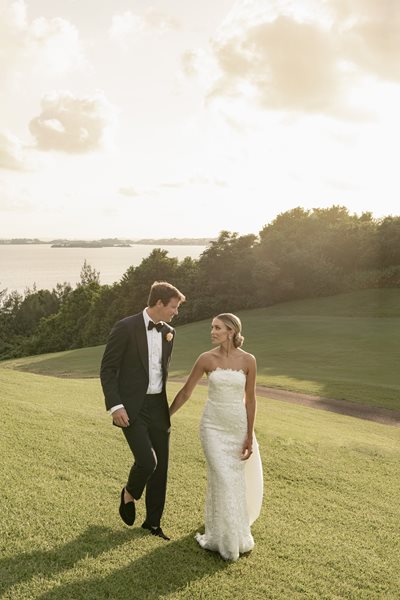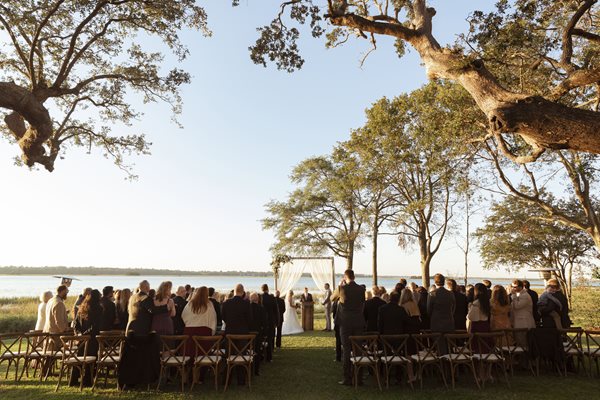
4 August 2024
How to Master Your First Wedding Photo Shoot: A Guide for Beginner Photographers
For photography instructor Melanie Fiander, photography is more than just capturing images; it's about weaving together moments, memories, and the essence of a place into a visual tapestry that tells a compelling story.
“Everywhere you turn, there is a picture waiting to be taken,” said Fiander, owner of Fiander Foto who teaches the Wedding & Event Photography for UC San Diego Division of Extended Studies.
A seasoned wedding photographer, Fiander’s artistic lens captures not just moments, but places and the stories they hold. Originally from Arlington, Va., Fiander and her husband split their time between Bermuda and Virginia. As a photographer, Fiander finds herself immersed in two distinct landscapes that profoundly influence her work. Bermuda's natural beauty, from its pristine beaches to its historic architecture, serves as a constant muse, infusing her photography with a unique sense of place.

“Bermuda is certainly a unique location for photographers,” she said. “I find the island’s natural landscape and colors to be inspiring. When capturing a wedding, event, or portrait session, I aim to shoot wide-angle images to include my subjects and also to highlight the natural surrounding features. This may consist of showcasing the unique attributes of the island’s beaches, nature reserves, Bermudian architecture, or historic sites.”
Fiander’s portfolio extends far beyond Bermuda's shores, having documented weddings in picturesque locales around the globe. Her top three international shoots — from the historic elegance of Ca 'Marcello in Italy to the majestic Errol Park Estate in Scotland and the timeless charm of Chanler at Cliff Walk in Newport, Rhode Island — reflect not only her keen eye for venues but also her knack for capturing the essence of each couple’s story against stunning backdrops.
“Each of the three venues boasts architectural designs that reflect the environment and the culture of its location as well as the time when it was built,” Fiander said. “Similar to the approach I take when I shoot in Bermuda, I aim to include wide-angle and close-up shots of the actual wedding venue and where the couple chose to spend their special day.”
What sets Fiander apart is her approach to wedding photography as a narrative art form. Drawing inspiration from documentary photography and her studies at the Salt Institute for Documentary Studies in Portland, Maine, Fiander embraces each wedding as a chapter in a larger visual story.
“As a storyteller, I’m drawn towards the history of the venue along with the personalities of the couple, their love story, and the memories we captured during my time with them,” she said.
Fiander said establishing clear communication and connections with her clients is key to fostering a relaxed atmosphere during a shoot, which is especially crucial during sunset bridal portraits, when she has exclusive time with the couple. Here, her communication skills are vital in directing poses, capturing genuine emotions, and ensuring the couple feels authentic and comfortable in front of the camera.
"Part of my job as a wedding photographer is to make my clients feel comfortable in front of the camera. If I can form a connection with my clients, I think there's a better chance their personalities will shine through the photographs more so that their images will seem more authentic," she said. "This is what I enjoy the most about wedding photography, connecting with others on both a professional and personal level."
Fiander – who bought her first camera, a Pentax K1000, when she was 17 – always knew she wanted to be a photographer, but didn't envision herself being a commercial photographer, at first.
"When I attended undergrad at Lynchburg University, I was interested in portraiture. I had an amazing photo professor named Patty Lyons," she said. "Patty introduced me to the works of Sally Mann, Mary Ellen Mark, and Nan Goldin; all strong female storytellers and photographers."
The following year, one of Fiander's classmates from the Salt Institute asked Fiander to capture her wedding.
"I was 23 at the time and shot the whole day with my Nikon F100 and 35mm film. Before the wedding, I remember thinking I would approach the day with a documentary style, meaning I would use the 'fly on the wall' approach," Fiander said. "Although, at the end of the day, I also remember thinking, 'That was way harder than I thought it would be.' Any mistake a rookie could make, I likely made it on that day. My first wedding was an overwhelming experience, but in a good way. I enjoyed the moments I captured and the challenge behind it; I did not want to give up."

Although Fiander said she made some beginner’s mistakes with her first wedding shoot, she has found ways to improve ever since. She offered some tips for capturing successful wedding photos:
- Scout the location beforehand to find unique spots to take images. This approach allows you to become familiar with how to get to the venue and where to park. The last thing you want is to arrive at a reception venue, not know where to go, and miss moments because you're trying to park the car.
- Master your lighting and exposure. This is a tip that is developed—pun intended—over time. Each venue is different so the lighting and exposure will ultimately also be different. Throughout a wedding day, I aim to shoot a variety of exposures from the same scenes. Bracketing my shots can help me when I sit down to edit. (Explore the Photography: Images and Techniques Certificate!)
- Shoot with two cameras. I have a 24-70mm lens on one camera and a prime zoom (either an 85mm or 100mm) on the second camera. This helps to avoid having to change lenses back and forth during the day. During a ceremony, however, I will swap my camera with the prime lens for a third camera that has an 80-200mm lens attached. While it may seem like a lot of gear, moments can occur very quickly at a wedding. Having the proper lenses already attached makes a huge difference. Not to mention, having three cameras on hand is helpful if one camera fails and/or gets dropped. You always want to have a backup camera ready.
- Bring extra gear. In addition to packing the multiple cameras, pack extra batteries, memory cards, strobes and/or flashes, business cards, water, and snacks.
- Create a photography timeline with the couple for their wedding day. When creating this timeline, it's important to be realistic about how much time is needed to capture the moments successfully as well as to factor in any travel time. Share the timeline with the planner; ask both the planner and the couple to share the other vendors. Ask the planner and/or the other vendors if anything needs to be shuffled around to suit their needs for the wedding day. Keep in mind: as a photographer, you’re working as a team with everyone there, including the couple. It’s important to consider what members of the team need in terms of timing as well.
The tips above can certainly help a wedding photographer reach their goals when it comes to capturing and developing successful images. However, Fiander said running a successful wedding photography business may also include the following:
- Website: Having a professional and up-to-date website is helpful.
- Social Media: Having a strong and active online social media presence related to a wedding photography business is key. (Check out Melanie’s Instagram).
- Advertisements / Listings: Let your networks and communities know that you're working as a wedding photographer. This may include an advert in the local phone book, on a wedding blog that’s geared towards a particular area, and/or on social media.
- Network: Speak to the event planners of different venues that host weddings. Introduce yourself, share your work, and ask if they will consider adding you as one of their preferred vendors. The same method of networking can be used with other vendors: planners, bands, DJs, hair/makeup artists, and videographers.
While the wedding photography business is very competitive, Fiander said it's important to be aware of your competition and to seek inspiration from other photographers.

“It's also important to not obsess over your competition. In other words, focus on your bookings, your clients, and perfecting your craft," she said. "Along with keeping the tips above in mind, it may be a good idea to see what other wedding photographers in your area are offering. From there, see what you can offer a couple that would be a little different. This may mean that you offer a better price and/or that you include something special with their package."
Fiander is excited to help her UC San Diego Extended Studies students take their wedding photography to the next level.
“I'm continuously impressed with students at Extended Studies because they are so passionate about their studies and want to learn the material," said Fiander, who has taught several different photography courses for UC San Diego Extended Studies. "Often, students will reach out to me directly to ask follow-up questions about the course material and chat about what it's like to work as a photographer. I have also found a great sense of support from the other instructors and the two project managers I have worked under thus far."

Are you ready to discover and boost your wedding photography skills? By taking Fiander’s Wedding & Event course, you will be empowered to capture not just moments, but emotions, stories, and connections that truly make weddings memorable.
Do you have questions about the Wedding & Event Photography course? For all inquiries, reach out to unex-digital@ucsd.edu. All UC San Diego Extended Studies Photography courses are fully accredited and taught by skilled, working professionals.